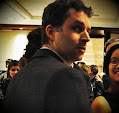I basically started from the business-y idea that, these days, if you're standard, you are bound to get commodified. Then I moved into the identity realm with the good news is that each of us, to borrow Walt Whitman's words, "contains multitudes" - our personality has multiple facets.
When we move into any social space we have to choose which of our faces to show. At any given moment, a few of them are visible. The others are hidden, often because we think they are somehow "weird". What I tried to do was to pack up my current thinking about the advantages and drawbacks of showing lesser-known aspects of ourselves, and outline a few strategies to go about it.
I believe the influence of a few bright lights showed in the talk, notably Lilia Efimova, Alexandre Enkerli, Sylvain Carle, Karl Dubost, and danah boyd.
For the occasion, I decided to give presentation tool Prezi a spin. I was blown away. The interface totally rocks, and the end result is, in my opinion, much more entertaining than a pile of slides - without sacrificing understandability.
I think one of the strong points about Prezi is the intelligent use of motion. In the PowerPoint context, you can incorporate animation elements, but in my experience it usually distracts more than it helps. By contrast, I believe that motion in Prezi can really help tell a story. Now I'm a total noob, still really improvising with it. I'm pretty sure I'm not using it 100% correctly, but it certainly feels exciting to work with that tool.
Anyhow, here's the Prezi: (click More > Fullscreen to get the best experience)
And here are the live notes from Alexandre Enkerli:
And here are the live notes from Alexandre Enkerli:
@sebpaquet Montreal-style (English slides, French speech).
@sebpaquet Finding the specificity from own skills which are unique in aggregate.
@sebpaquet Contrary to high school, context allowing personal weirdness. Not pleasing everyone but finding like-minded peeps.
@sebpaquet thought-provokes through appropriate use of imagery and shared references. Adapted to crowd.
@sebpaquet primacy of personal context and move toward relative open-mindedness and rapport-induced weirdness-tolerance.
@sebpaquet Non-judgmental approach to diversity of strategies. Insight on potential issues including context-collapse.
@sebpaquet uses a large but manageable number of concrete examples in discussion of rather abstract points.
Federating identities through standardized tools.
pubwich on aggregating identities through feeds as php libraries. Power.com
@dianebourque on soup.io but Pubwich as Quebec-developed tool.
on intrapersonal process for stiff-intolerant/weird-tolerant interpersonal dynamic. Agency?
Black hole of open culture, forcing transparency.
Advantages of multiple-specialization in potentially faddish reality. Flexibility, learning how to learn, interdisciplinarity.





